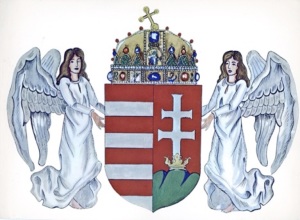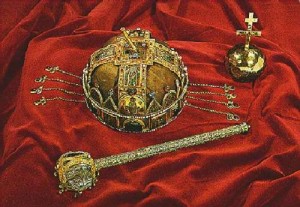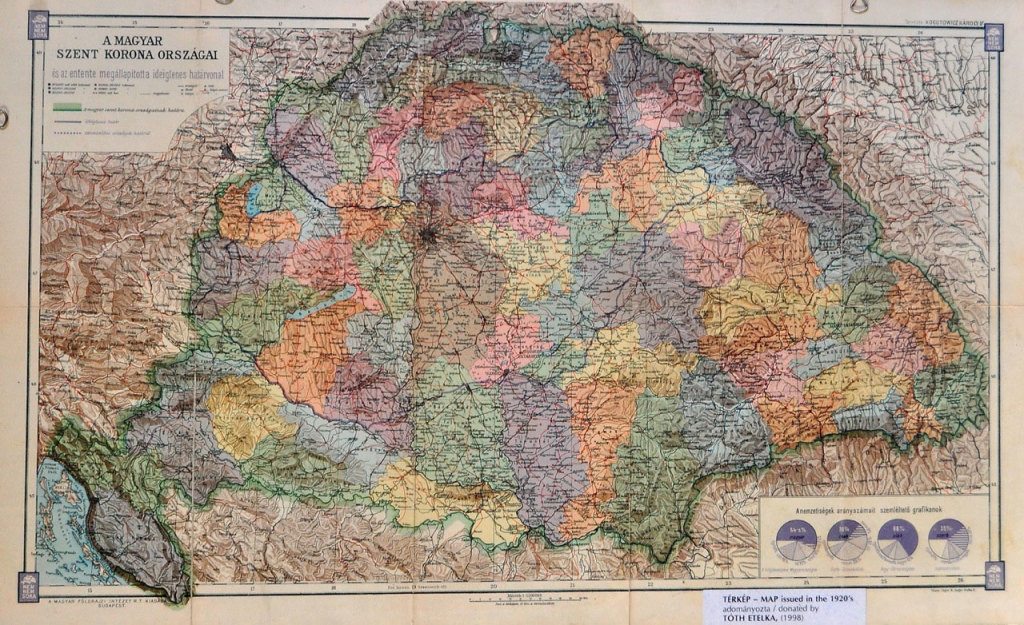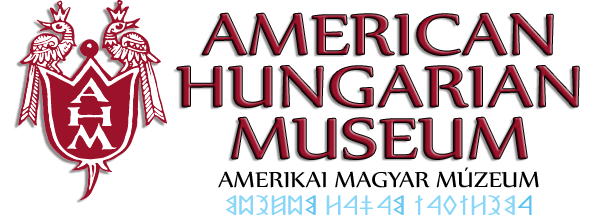
Brief History of Hungary
1100 years of statehood in the Carpathian Basin,
1000 years of Christian Kingdom,
40 years since the 1956 Freedom fight.
In 1996 Hungarians were celebrating the 1100th anniversary of their settlement and statehood in the Carpathian Basin in Central Europe. History teaches us of the presence of early Magyars in this geographical region since Hunnic times (Székelys) – 4th. Century – and Avar times (White Magyars 670 A.D.). The last major wave of Hungarians entered the Carpathian Basin under the leadership of Álmos and his son Árpád, the elected sovereign, founder of the Árpád Dynasty. Scholars estimate their number to be 500,000. In 907, the United West-European powers attacked the newly founded nation, but the decisive victory of the Magyars in the Battle of Pozsony assured the nation’s existence for the coming 1000 years. The Árpád Dynasty, which ruled for 406 years, had intensive political and marital contacts with the nations of Europe all the way to England (St. Margaret Queen of Scotland was the granddaughter of King St. István). The Magyars fought repeatedly in western alliances in the 10th century. They have been in early contact with Oriental Christianity and Christianity of the Byzantine rite, before turning toward Roman Catholicism under the leadership of kings Géza and his son St. István (Stephen) at the end of the 10th century. From this time on, Hungary became a bastion of western Christendom for the next thousand years. 12 members of the House of Árpád were canonized.
Hungarians had a highly developed brilliant artistic style in gold, silver and bronze paralleled in medieval architecture, folkart and embroidery. Their unique folk music has roots far to the East in Central Eurasia. They had their own runic writing, which can be compared to shorthand in structure, and because carved in wood it was suitable for printing.

King St. István (997-1038) founded ten dioceses and reorganized Hungary politically and economically. He requested and received the crown from Pope Sylvester II, and was crowned king in 1000. The Holy Crown of Hungary, a symbol and depository of constitutional power, was the symbolic holder of the supreme power of the State until 1945.
King St. László (1077-1095) annexed Slavonia and Croatia at the request of their queen, his sister, and since then till 1920 these countries were part of Hungary enjoying her protection. King László founded the episcopacy of Zagreb, and built a magnificent cathedral there. He canonized king István and his son Imre.
King Kálmán (1095-1116) issued a decree forbidding witch-hunts and trials in Hungary because “witches do not exist”. This decree was observed for centuries.
In 1222 King Endre II (1205-1235) issued a royal decree, the “Bulla Aurea” (Golden Bull), considered to be Hungary’s first written constitution. It sets the rights and limitations of the king, nobility and small landholders. King Endre led a crusade to the Holy Land.
In 1241-42 during the Mongol invasion the country was destroyed and half of the population, which numbered two million, was exterminated. King Béla IV (1235-1270) rebuilt the country and six years after the invasion, Hungary once again stood as the strongest power in Central Europe.
King László IV (1272-1290) helped the Habsburg family onto the Austrian throne, and consequently to immense power in European history up to the 20th century, by defeating the Czech king Ottokar in the Battle on the Plain of Morava in 1277.
In 1301 the House of Árpád died out and members of the Anjou family, also descendants of Árpád on the female line ascended to the throne. Under Lajos the Great (1342-1382), who founded the University of Pécs in 1367, Hungary reached the greatest territorial expansion in her history.
At the beginning of the 15th century the Ottoman Empire started to expand towards Europe. János Hunyadi who dedicated his entire life and fortunes to defeat the Turks and drive them out of Europe temporarily stopped their advance. His most famous victory was the battle of Nándorfehérvár (today Belgrad) in 1456. Hunyadi’s comrade in arms and most avid supporter at Nándorfehérvár was János (John) Capistrano, a Franciscan monk, who formed a crusading army by recruiting thousands of Hungarian peasants. In memory of this victory, pope Callixtus III ordered the midday ringing of church bells all over the world, a custom still observed today.
Hunyadi’s son Mátyás (1458-1490), also called Mátyás the Just was one of the most popular kings. He was a great patron of the arts and sciences, a true renaissance king. His library, the Corvina, was world famous, and the few existing pieces are still held in high esteem. During his reign a printery was established in Buda, and the first book was printed in Hungary in 1473.
In 1526, the Ottoman Empire under Suleiman the Magnificent attacked Hungary at Mohács, the battle known as the “Graveyard of Greatness”. During the 150 years of Turkish occupation the country was destroyed due to constant warfare. Entire cities and villages disappeared. The Hungarian population was reduced from 4 to 1.4 million people, making room for immigration from neighboring regions. (The repeated decimation of the Magyar people led to the happenings in 1920, when these same neighbors demanded 1000-year-old Hungarian territories on the grounds that their people lived there.) The Habsburgs ruled Northern and parts of western Hungary. Only the Principality of Transylvania (Erdély) remained independent, and was the citadel of Hungarian spirit. Already in 1557, the Diet of Torda declared that all men could follow the religion of their choice. In 1558, the same Diet institutionally codified religious freedom, providing asylum to those persecuted in other European countries because of their religion.
In 1686, Hungary was liberated from the Turks, but came under Habsburg rule and the suffering of the people continued. As a consequence, under the leadership of Prince Ferenc Rákóczi, the Hungarians started their first significant freedom fight (1703-1711) against Habsburg domination. Independence could not be obtained and economic and cultural development was hemmed by the subsequent oppression. Nevertheless the country was rebuilt. Count István Széchenyi had a leading role in the spiritual and economic “regeneration” of Hungary.
In 1848-49 Hungarians fought again for independence against the Habsburgs, and could only be defeated when 200,000 Imperial Russian troops entered the country at the request of the Austrians. Bloody oppression followed. In 1867, the Compromise was negotiated, which assured Hungarians limited independence and freedom. Franz Joseph of Habsburg was crowned king and the Austro-Hungarian Monarchy was formed.
As a member or the Austro-Hungarian Monarchy, Hungary was forced to take part in World War I. (1914-1918). A devastating tragedy struck the country after World War I, when the Peace Treaty of Trianon had to be signed by Hungary in 1920. 71% of her territory, two thirds of her population and all her valuable assets below and on the surface were lost to neighboring and newly formed countries. The thousand-year old State was broken up into 7 pieces.
Hungary was forced to enter World War II in 1941. By 1944 the country became a battleground for the Russian offensive against the German army. From 1945-1989 Hungary was occupied by the Soviet army and ruled by a Soviet type communism. The Magyars could not tolerate the immense oppression and fought again for their freedom. On October 23, 1956 they rose against the hated Soviet communist tyranny. The Red army and their 5,000 tanks crushed the freedom fight. Thousands were executed and imprisoned and nearly a quarter million people fled the country.
In 1989, Communism collapsed. The following year free elections took place and the Soviet troops left the country in 1991.
Hungary was at the crossroads of the warring nations of East and West, South and North during her entire history. The nation, rich in scholars, scientists (10 Nobel-prize winners of Hungarian descent), inventors, sportsmen, artists and musicians, remembers her glorious past together with the tragedies and looks with great hope and faith towards the next 1000 years.
God bless the Magyars!
Emese Kerkay (1996)

